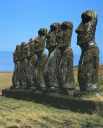|
Chile Limits Tourist Stay on Easter Island
August 1, 2018 Chile has set a limit on the number of days that Easter Island visitors can stay. 
The Santiago government has reduced the length of a stay allowed to tourists and non-locals from 90 days to 30 days. A Tourism Ministry spokeswoman said that the government was seeking to protect the island, which is well-known for its famous large stone heads, known as moai, in the wake of increased tourist traffic in recent years. Several hundred of the large statues, some 30 feet tall, dot the island and have long been a magnet for curious anthropologists. The Dutch explorer Jacob Roggeveen landed on the island in 1722. Spanish and French explorers followed, as did Britain's famed James Cook, in 1774. Chile, which is 2,200 miles to the east, annexed the island in 1888. 
Tourism has grown steadily since the Chilean government opened up the island to visitors, in 1966, in the same year granting island residents status as Chilean citizens. Before then, the island was a sheep farm. The island as a whole is a UNESCO World Heritage Site and, to this day, home to many archeological digs. Tourist numbers have grown dramatically this century, from about 20,000 in the early 2000s to more than 70,000 in 2017. As well, the population has increased, from 1,936 in 1982 to 5,761 as of the last census, taken in 2012. Island officials are concerned about a marked increase in the amount of garbage and sewage generated by the increase in residents and tourists. The triangular island has an overall area of only 63 square miles, about the size of Liechtenstein. The government is also just about ready to vote on a bill that changes the island's name to Rapa Nui, which is already how residents refer to their home. |
Social Studies for Kids |
Social Studies for Kids
copyright 2002–2019
David White




